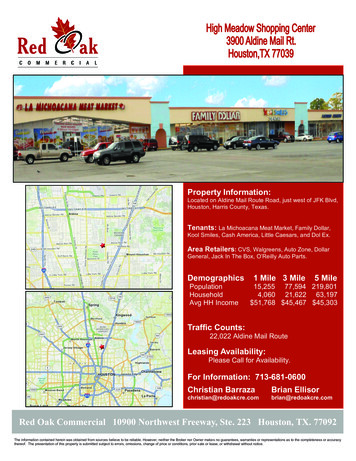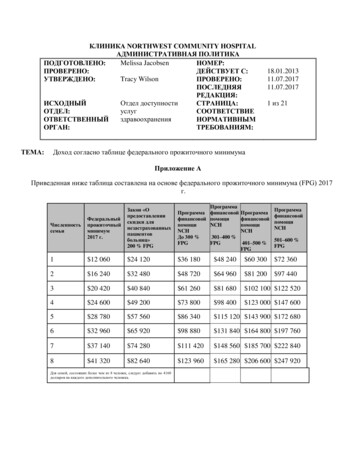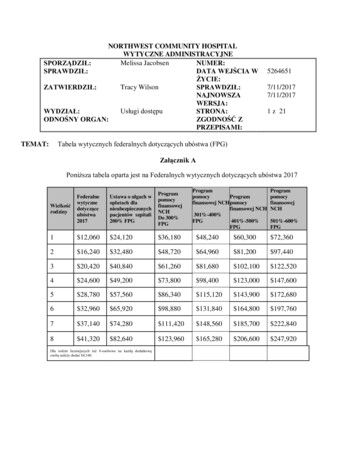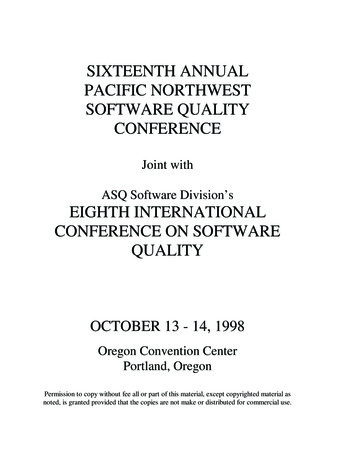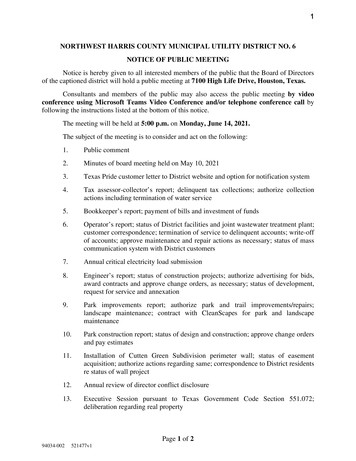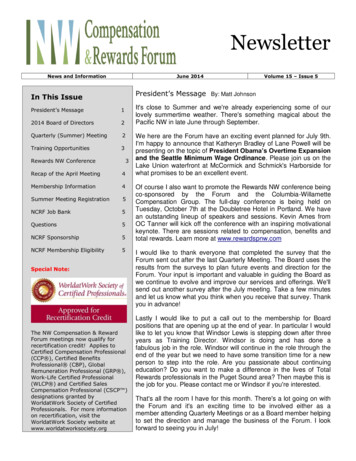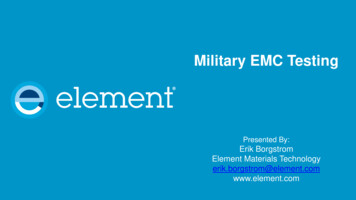
Transcription
Military EMC TestingPresented By:Erik BorgstromElement Materials m
EMC Testing vs. Environmental Testing – Earth(quake)!
EMC Testing vs. Environmental Testing – Wind (& Rain)!
EMC Testing vs. Environmental Testing – Fire!
EMC Testing vs. Environmental Testing – RF Susceptibility
EMC Testing for Military EquipmentUnlike many Environmental tests, EMC testing is typically not veryinteresting to watch – in fact, it is boring But we LIKE it that way!!This talk will be an overview of the EMC testing requirements for Militaryequipment and systems.Although EMC testing can (and should) be boring, the hope is that this talkwill NOT be boring – but this depends at least in part on YOUR participation.But if you do fall asleep, I will not take offense – as long as you don’t snore
Military EMC Environments Can Be Harsh
The Consequences of an EMC Problem can be (and have been) Severe (and Tragic). USS ForrestalFalklands warF-111s over LibyaUH-60 problemsJoint ops problems in Somalia & Iraq
EMC Testing – MilitaryEMC is Required by Military Regulations – Though enforcement is notuniversal EMC testing requirements are based on the Environment(s) of IntendedUse: Ground Vehicles, Personnel, Buildings Aircraft Air Force, Army, Navy Shipboard Army/Navy, Above/Below Decks, SubmarinesSusceptibility test levels and Emission limits are different based on the installation(“Platform”) where the system is usedStandard for Military EMC in the US (and in most of the rest of the world) is MIL-STD-461G
Before MIL-STD-461 . In the OLD Days . Each Service (Army, Navy, Air Force) had separate EMC requirements and tests. In some cases, a new platform (ship, airplane, vehicle) would have completely new anddifferent EMC specifications!
MIL-STD-461 History Written by the Tri-Service Working Group MIL-STD-461 (and 462) published in 1967 461: Requirements 462: Test Methods and Procedures MIL-STD-461A published in 1968MIL-STD-461B published in 1980MIL-STD-461C published in 1986MIL-STD-461D published in 1993 MIL-STD-462D also published in 1993 Multiple “Notices” for MIL-STD-462 released between 1967 and 1993 MIL-STD-461E published in 1999, incorporating test methods from 462 MIL-STD-461F published in 2007 MIL-STD-461G published in 2015 Significant Change in Section 4 “General Requirements” “After the initial calibration, passive devices such as measurement antennas, current probes, and LISNs, require nofurther formal calibration unless the device is repaired. The measurement system integrity check in the procedures issufficient to determine acceptability of passive devices.”
MIL-STD-461G “REQUIREMENTS FOR THE CONTROL OF ELECTROMAGNETICINTERFERENCE CHARACTERISTICS OF SUBSYSTEMS AND EQUIPMENT” “This standard establishes interface and associated verification requirements for thecontrol of the electromagnetic interference (EMI) emission and susceptibilitycharacteristics of electronic, electrical, and electromechanical equipment andsubsystems designed or procured for use by activities and agencies of the Departmentof Defense (DoD).” 19 Tests Methods with requirements and procedures 3 Conducted Emissions10 Conducted Susceptibility3 Radiated Emissions3 Radiated Susceptibility Appendix A: Detailed and extensive “Application Guide”
Related Standards RTCA/DO-160: Environmental Conditions and Test Proceduresfor Airborne Equipment MIL-STD-704: Power Input Requirements for Aircraft MIL-STD-1275: Power Input Requirements for Ground Vehicles MIL-STD-1399, Section 300: Power Input Requirements for Ships MIL-STD-464: Electromagnetic Environments ADS-37A-PRF: EMI Performance and Verification Requirementsfor (Army) Aviation Systems
RTCA/DO-160G Published by RTCA, Inc., a Not-for-Profit corporation “Environmental Conditions and Test Procedures for Airborne Equipment” “. defines a series of minimum standard environmental test conditions (categories) andapplicable test procedures for airborne equipment. The purpose of these tests is toprovide a laboratory means of determining the performance characteristics of airborneequipment in environmental conditions representative of those which may beencountered in airborne operation of the equipment.” 3 sections of General Information 13 sections covering the Physical Environment 10 sections on Electrical / Electromagnetic Environment 3 appendices
MIL-STD-461G and DO-160GMIL-STD-461 (Method)DO-160 (Section) TestRE101 (Sort of)15Magnetic Effect / Magnetic Field Emissions(MIL-STD-704), CE10116Power InputCS106 (461F)17Voltage SpikeCS10118Audio Frequency Conducted Susceptibility - Power InputsCS109, CS115, CS116, RS10119Induced Signal SusceptibilityCS114, RS10320Radio Frequency Susceptibility (Radiated and Conducted)CE102, RE10221Emission of Radio Frequency EnergyCS11722Lightning Induced Transient SusceptibilityCS11825Electrostatic Discharge MIL-STD-461G CE106, RE103, CS103, CS104, CS105: equivalent tests in FAA regulations (TSO MOPS) DO-160G Section 23 (Direct Strike Lightning): equivalent requirements in MIL-STD-464C MIL-STD-461G RS105 (NEMP): no equivalent test in DO-160G or FAA regulations (yet)
MIL-STD-461G Test Methods
MIL-STD-461G Test Method Applicability
CE101 0.03-10kHz, power leads only, measured with a current probe
CE101 -- Limits
CE101 Test Setup
CE102 CE102: Conducted Emissions, Radio Frequency Potential, Power Leads 0.01 to 10MHz, power leads only5 limits depending upon input voltageMeasurement using LISN RF portNo significant change for MIL-STD-461G
CE102 Test Setup
CE106 CE106: Conducted Emissions, Antenna Port Limits: Receivers, Transmitters and amplifiers (standby mode): 34 dBμV Transmitters and amplifiers (transmit mode): Harmonics, except the second and third, and all other spurious emissions shall be atleast 80 dB down from the level at the fundamental. The second and third harmonics shall be suppressed to a level of -20 dBm or 80 dBbelow the fundamental, whichever requires less suppression. For Navy shipboard applications, the second and third harmonics will be suppressedto a level of -20 dBm and all other harmonics and spurious emissions shall besuppressed to -40 dBm, except if the duty cycle of the emissions are less than 0.2%,then the limit may be relaxed to 0 dBm.
CE106 Test Setup
CS101 CS101: Conducted Susceptibility, Power Leads 0.03 to 150kHz frequency range; test levels up to 8% of input rms voltage2 test levels: 28V or less; 28VPre-calibrated power limit up to 80WNo significant changes for MIL-STD-461G
CS101 Test Setup
CS101 Test Levels
CS103/104/105 CS103: Conducted Susceptibility, Antenna Port, Intermodulation CS104: Conducted Susceptibility, Antenna Port, Rejection of UndesiredSignals CS105: Conducted Susceptibility, Antenna Port, Cross Modulation
CS103/104/105 Test Setup
CS106 (MIL-STD-461F) CS106: Conducted Susceptibility, Transients, Power Leads 5 micro-second spike 2 ohm source impedance400V test level, pre-calibrated across 5 ohmsEliminated in 461G
CS106 Test Setup
CS109 Conducted Susceptibility, Structure Current 0.06 to 100kHz frequency range, 1 test level No significant changes for 461G
CS114 CS114: Conducted Susceptibility, Bulk Cable Injection 0.01 to 200MHz, 1kHz SW modulation only 5 test levels (“Curves”) depending upon the details of theinstallation/platform Special 4-10kHz test for Navy ships & submarines at 77dBuA Pre-calibration in a 50 ohm fixture, induced current monitored during test Significant change for MIL-STD-461G: Test System Verification with monitorprobe in a 2nd 50 ohm fixture
CS114 Test Levels
CS114 Test Level Applicability
CS114 Calibration and Verification Setups
CS114 Test Setup
CS115/CS116 CS115: Conducted Susceptibility, Bulk Cable Injection, Impulse Excitation 30 nSec pulse, 30 Hz rep rate, 1 test level: 5A peak, pre-calibrated in 50 ohm fixture CS116: Conducted Susceptibility, Damped Sinusoidal Transients, Cables andPower Leads 0.01, 0.1, 1, 10, 30, & 100MHz test frequencies Test levels up to 10A peak, pre-calibrated in 50 ohm fixture or actual induced current duringtest No significant changes for 461G 461E: Air Force test level for CS116 5A max
CS115 Test Waveform
CS116 Test Levels
CS115/CS116 Calibration and Test Setups
Lightning
Lightning
Lightning Induced Transient Susceptibility: CS117 CS117: Conducted Susceptibility, Lightning Induced Transients, Cables andPower Leads. NEW for MIL-STD-461G Multiple Burst and Multiple Stroke waveforms applied to interconnecting cables andpower leads Pin Injection tests NOT performed Cable Induction only, Ground Injection not supported 6 Waveforms, 2 Test Levels (Internal or External Equipment) Test Levels given for full cables and individual power leads Multiple Stroke Waveform 1, 2, & 3 required for all installations Multiple Stroke Waveform 4 & 5A required for installations in areas with composites Multiple Burst Waveform 3 required for all installations Multiple Burst Waveform 6 required for installations that “ utilize short, low impedancecable bundle installations.” – such as engine harnesses
CS117 Waveforms and Test Levels
Waveform 1
Waveform 2
Waveform 3
Waveform 6
Multiple Stroke Waveform
Multiple Burst Waveform
CS117 Cable Injection Lightning Test Setup
CS118 Electrostatic Discharge NEW for MIL-STD-461GPatterned after EN 61000-4-2 (150pF & 330 ohm)Contact Discharge at /-8 kV for conductive surfacesAir Discharge at /-2 kV to /-15 kV only required where Contact Discharge cannot beapplied Connector pins are NOT tested ESD Generator must be calibrated using a precision (expensive) target and a 1 GHz(expensive) digital oscilloscope, before EVERY TEST
CS118 Calibration
CS118 Calibration Setup
CS118 Test Setup
RE101 RE101: Audio Frequency Magnetic Field Emissions Measurement made with a small loop antenna, 7cm from EUT surface30Hz to 100kHz2 Limits: Army & NavyNo significant changes for 461G
RE101 Test Limits
RE101 Test Setup
RE102/RE103 RE102: Radiated Emissions, Electric Field Anechoic Chamber only 9 limits (10kHz to 18GHz or 2MHz to 18GHz) depending upon details of installation Significant change for MIL-STD-461G: Note stating - “Testing is required up to 1 GHz or 10 timesthe highest intentionally generated frequency within the EUT, whichever is greater.” - HAS BEENDELETED. Testing to 18GHz is now REQUIRED for ALL equipment and systems. RE103: Radiated Emissions, Antenna Spurious and Harmonic Outputs Used only when CE106 is not possible Setups similar to RE102 Limits: Harmonics, except the second and third, and all other spurious emissions shall be at least 80 dB downfrom the level at the fundamental. The second and third harmonics shall be suppressed to a level of -20 dBm or 80 dB below thefundamental, whichever requires less suppression. For Navy shipboard applications, the second and third harmonics will be suppressed to a level of -20dBm and all other harmonics and spurious emissions shall be suppressed to -40 dBm, except if the dutycycle of the emissions are less than 0.2%, then the limit may be relaxed to 0 dBm.
RE102 Limit - Ships and Submarines
RE102 Limit - Aircraft
RE102 Limit - Ground
RE102 Test Setup
RS101 RS101: Radiated Susceptibility, Magnetic Field Small radiating loop antenna, 5cm from EUT surface30Hz to 100kHz2 Limits: Army & NavyNo significant changes for 461G
RS101 Test LevelsNavyArmy
RS101 Test Setup
RS103 RS103: Radiated Susceptibility, Electric Field Test levels from 5V/m to 200V/m, 1kHz SW only 30MHz to 18GHz applicable for all, 2-30MHz and/or 18-40GHz optional (must be specified) Frequency step size varies with frequency range (5% to 0.25%); 3 second minimum dwell time Anechoic Chamber Method Placement and performance of RF Absorber is specified“Real-time” E-field measurement during test using E-field sensorsSensors placed on or near the EUT, directly opposite the transmitting antenna 200MHz, antenna is centered on the “test setup boundary” 200MHz, EUT and the first 35cm or 7cm of cabling must be within the 3dB beamwidth of the antennaVertical ( 2MHz) and Horizontal ( 30MHz) antenna polarizations and a 1 meter antenna distance required“EUTs shall be oriented such that surfaces which respond most readily to radiated signals face the antennas ” ;-)Significant change for MIL-STD-461G: No option for anechoic chamber field measurement with receive antenna Reverberation Chamber Method 200MHz only, mode-tuned onlyLowest usable frequency for a given chamber is based on chamber size (volume)Chamber calibration with EUT in place using E-field sensor or ( 1GHz) receive antenna (2 different equations)Number of Tuner steps (12 to 50) is specified by frequency range
RS103 Test Levels
RS103 Test Setup
RS103 Test Setup
RS105 RS105: Radiated Susceptibility, Transient Electromagnetic Field Test level 50kV/m Anechoic chamber required
RS105 Test Setup
Summary MIL-STD-461G incorporates significant changes: Section 4 – Calibration of passive devicesCS106 eliminatedCS114 – system verification procedure expandedCS117 addedCS118 addedRE102 – option to limit frequency range to 1GHz eliminatedRS103 – option to measure field level with antenna eliminated
Questions?
Thank you!
RTCA/DO-160: Environmental Conditions and Test Procedures for Airborne Equipment MIL-STD-704: Power Input Requirements for Aircraft MIL-STD-1275: Power Input Requirements for Ground Vehicles MIL-STD-1399, Section 300: Power Input Requirements for Ships MIL-STD-464: Electromagnetic Environments ADS-37A-PRF: EMI Performance and Verification Requirements for (Army) Aviation Systems. RTCA/DO-160G .

